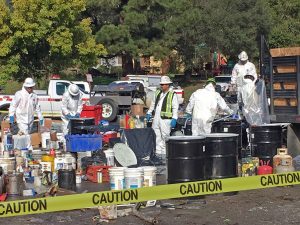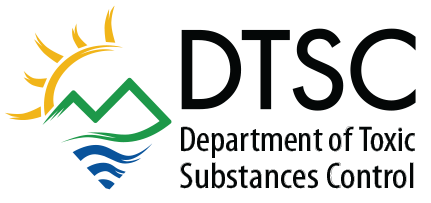Disaster-Related Hazardous Waste Removal

DTSC assists local, state, and federal agencies after major disasters, including wildfires and flooding, to remove household hazardous waste and other harmful substances, such as e-waste found on parcels and properties.
The contaminated debris is cleaned up and contained as quickly as possible to minimize exposure to emergency personnel, the public, the environment, and workers involved in restoration efforts.
Staff from DTSC’s Emergency Response Unit oversees contractors who remove household hazardous waste (HHW), asbestos, and e-waste from properties, impacted areas, or designated drop-off locations.

What is HHW?
Examples of HHW include lead-acid and household batteries; compressed gas cylinders; bulk pesticides, fertilizers, and pool chemicals; paints, thinners, and aerosol cans; asbestos siding, pipe insulation, and tiles.

What is E-Waste?
E-waste can include cathode ray tubes (CRTs) from televisions, computers, and other electronic devices.
DTSC Wildfire Clean-Up Dashboard 2024
The interactive dashboard below displays information about properties impacted by wildfires that DTSC has been asked to assess as the first steps toward recovery. The dashboard displays the number of parcels affected, the number of parcels assessed for household hazardous waste and bulk asbestos to date, and the number of parcels assessed each day.
To access the dashboard, click on the image below. A new browser tab will open to display the dashboard.
 Past Wildfires
Past Wildfires
To view the Wildfire Public Dashboard Maps for previous fires, please visit our Past Wildfires Public Dashboards page.
Helpful Information (Fact Sheets)
- Emergency Guidance on Wildfires #1: Handling Ash, Debris and other Hazardous Materials from Burned Structures
- Emergency Guidance on Wildfires #2: Management Options for Expedited Collection of Hazardous Wastes from Burned Areas
- Guía de Emergencia en Incendios Forestales #1: Manejo de Cenizas, Escombros y Otros Materiales Peligrosos de Estructuras Calcinadas
- Guía de Emergencia en Incendios Forestales #2: Alternativas de Gestión para una Recolección Agilizada de Residuos Peligrosos de Zonas Calcinadas
Video
An unrelenting series of wildfires have continued to devastate portions of our State. View the video below to find out more about the work DTSC does after a major wildfire.
Enforcement and Emergency Response Division Links
Hazardous Waste Links
- Hazardous Waste Home
- Certified Appliance Recycler (CAR) Program
- CUPAs
- Defining Hazardous Waste
- Electronic Waste (E-Waste)
- Enforcement and Emergency Response Division
- Facilities (TSDFs)
- Generator Improvements Rule
- Generators
- Hazardous Waste ID Numbers
- Hazardous Waste Management Plan
- Hazardous Waste Manifests
- Hazardous Waste Tracking System
- Household Hazardous Waste
- Metal Recycling
- Metal Shredding Facilities and Wastes
- Permitting
- Toxics in Products
- Transporters
- Universal Waste
- Form 1358
- California Hazardous Waste Codes
Hazardous Waste Related Links
- Annual/Biennial Reports
- Annual Fee Summary
- Customer Billing Portal (Cost Recovery)
- DTSC Advisory on the Management of Spent Fuels
- EnviroStor
- Hazardous Waste Publications
- Find a Registered Hazardous Waste Transporter
- Hazardous Waste Policies & Procedures
- Hazardous Waste Project Documents
- Imports and Exports of Hazardous Waste
- Kettleman Hills Facility
- Land Use Restriction Sites
- Office of Criminal Investigations
- PV Modules (Solar Panels)
- Regulatory Assistance Office
- Report an Environmental Concern
- Retail Waste
Connect / Contact Us
Office Locations / Map
Sign up for an E-List
Regulatory Assistance Officers
Statewide Campaigns/Alerts
Report an Environmental Concern
Amber Alert
California Grants Portal
Register to Vote
Save Our Water.com





 Katherine M. Butler, MPH
Katherine M. Butler, MPH